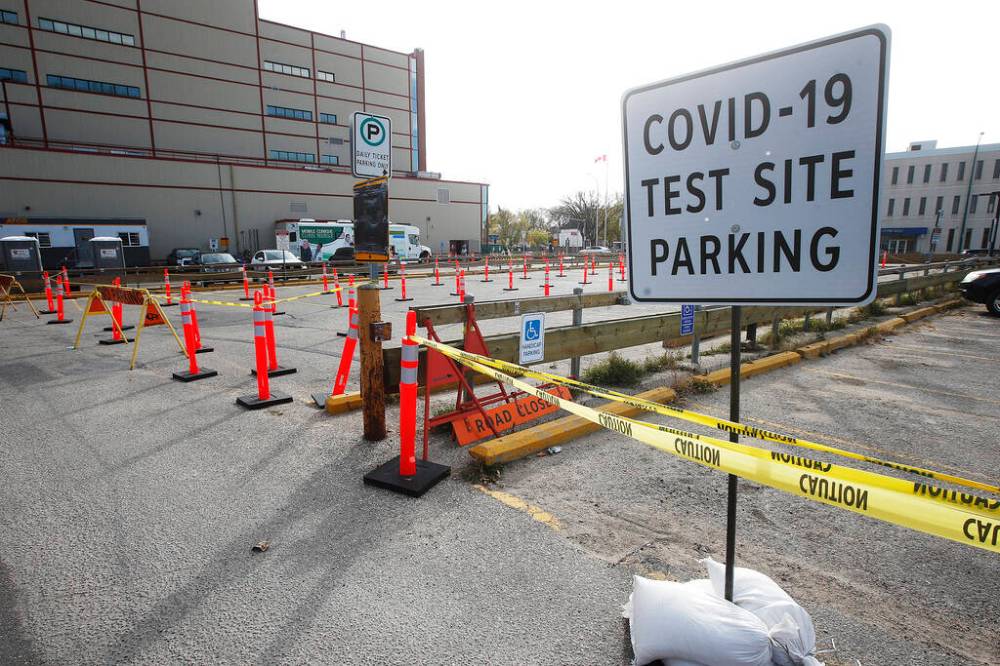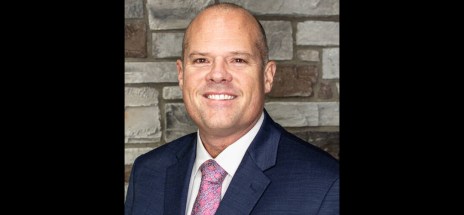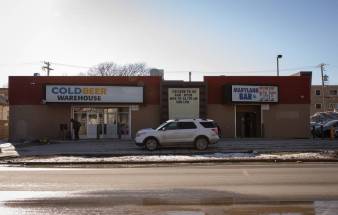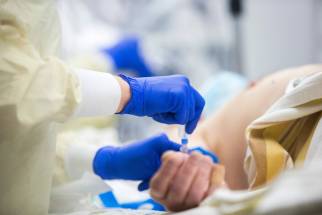Concerns grow as province dismantles pandemic machine Senior health officials go underground while virus cases appear to be rising again
Read this article for free:
or
Already have an account? Log in here »
To continue reading, please subscribe:
Monthly Digital Subscription
$0 for the first 4 weeks*
- Enjoy unlimited reading on winnipegfreepress.com
- Read the E-Edition, our digital replica newspaper
- Access News Break, our award-winning app
- Play interactive puzzles
*No charge for 4 weeks then price increases to the regular rate of $19.00 plus GST every four weeks. Offer available to new and qualified returning subscribers only. Cancel any time.
Monthly Digital Subscription
$4.75/week*
- Enjoy unlimited reading on winnipegfreepress.com
- Read the E-Edition, our digital replica newspaper
- Access News Break, our award-winning app
- Play interactive puzzles
*Billed as $19 plus GST every four weeks. Cancel any time.
To continue reading, please subscribe:
Add Free Press access to your Brandon Sun subscription for only an additional
$1 for the first 4 weeks*
*Your next subscription payment will increase by $1.00 and you will be charged $16.99 plus GST for four weeks. After four weeks, your payment will increase to $23.99 plus GST every four weeks.
Read unlimited articles for free today:
or
Already have an account? Log in here »
Hey there, time traveller!
This article was published 31/03/2022 (1351 days ago), so information in it may no longer be current.
The province is closing all COVID-19 testing sites and pulling the plug on contact tracing — putting hundreds out of work — as the government winds down its pandemic response, despite growing fears a new wave is just around the corner.
The call-centre firm 24-7 Intouch laid off staff involved in contact tracing Thursday, with other layoffs planned for vaccine booking, according to internal emails obtained by the Free Press.
“We were suddenly made aware that our work supporting the Government of Manitoba’s COVID-19 efforts was ending on March 31, 2022 and we rushed to inform everyone immediately,” reads an internal note to employees from company executives.

“With short notice, we continued to work to preserve jobs in the program, but were unsuccessful.”
Provincial officials dodged interview requests, but insisted that 24-7 Intouch wasn’t caught off-guard as the $61 million contract had long been set to expire Thursday.
In any case, the Manitoba Nurses Union argues Winnipeggers are being left without a buoy as COVID-19 waves hit other provinces.
“Are we going to see a (new) wave, right as we’re trying to ramp up surgeries?” said union president Darlene Jackson.
“Nobody knows if they’re positive, so it’s very scary right now for nurses.”
As of Friday, public-health officials will no longer inform the few people who could access PCR tests about their results. Testing centres are set to close April 15, with the exception of those run by some inner-city groups.
Thursday marked the last COVID-19 bulletin to explain the region, gender and age of deaths reported during the previous week. From now on, Manitoba will report deaths and confirmed cases in a weekly brief with less detail, similar to influenza surveillance. The definition of a COVID-19 death has also been curtailed to exclude people who also had certain illnesses.
University of Saskatchewan epidemiologist Nazeem Muhajarine said that makes it impossible to tell if Manitoba is in a new wave until virus cases begin to once again strain the health-care system.
“With forgoing our ability to pick up (new) cases through confirmed testing, like molecular-based PCR, we have compromised our ability to really measure (new) cases of COVID-19,” Muhajarine said.

“That then compromises our ability to say with confidence that we are seeing a sustained increase in cases, and therefore we have entered into a surge.”
Muhajarine, a professor based in Saskatoon, said Ontario seems to be entering a sixth wave, because it’s seeing a fast, exponential growth in cases that has continued to grow for more than a week.
Wastewater and absenteeism are other indicators that could indicate a surge, he said.
Generally speaking, Manitoba has been through five waves, with the last starting around Christmas and seeming to drop to a plateau in late February.
Wastewater data as of March 17 shows a slight rise of coronavirus load in one area of Winnipeg, with another static and a third in decline.
Jackson said nurses are seeing a gradual decline in hospital patients from the wave. But the worry is an anecdotal rise in Winnipeg infections will result in an onslaught of cases.
“I feel like we’re just starting to catch up, and waiting with bated breath to see whats going happen with this new (sub)variant,” she said.
The Omicron variant’s BA.2 sub-strain is known to be relatively less severe than Delta, but even more contagious than the Omicron mutaion that maxed out Manitoba’s testing capacity in December when it spread like wildfire across the province.
Even if a minority of those infected end up in hospital, exhausted nurses are worried they’ll have a volume of patients large enough to cause surgeries to once again be delayed, Jackson said.
That’s possible, Muhajarine said, because by the time strain on a health-care system is observed there has already been widespread exposure to the coronavirus.
“We are not done with seeing people ending up in hospital needing care for COVID-19 yet, particularly after all the public-health measures have been lifted,” he said.
“We are still in this. I think we will have some rough times ahead still, before it gets better.”
The Free Press requested interviews Thursday with Health Minister Audrey Gordon, chief provincial public health officer Dr. Brent Roussin, and his assistant, Dr. Jazz Atwal.
None were available; instead a spokesman said it’s up to Manitobans to protect themselves.
“As Manitoba transitions to this next phase of the pandemic, Public Health has advised our government that fluctuations in COVID-19 activity is expected and that vaccination, including a booster dose, continues to provide good protection against severe disease,” wrote Gordon’s spokesman Draper Houston.
The government “encourages Manitobans to follow public health recommendations” — all of which are now optional, “including staying home when sick” and “considering additional measures such as masking, physical distancing, and keeping gatherings small based on individual risk and preference.”
A Manitoba Health spokesperson told the Free Press “an increase in cases following the removal of public health restrictions was expected.”
The opposition parties say the Progressive Conservatives are hiding the data amid an anecdotal rise in cases, making it impossible to tell whether Manitoba is in or about to enter a sixth wave.

“This government making the decision to not be transparent, and to withhold that data they have from Manitobans is a mistake,” said NDP health critic Uzoma Asagwara.
“It doesn’t facilitate trust… in decision-making.”
The MLA argued the premier and cabinet need to be more visible and help the public understand where Manitoba is headed.
“The government puts out several (news) releases, randomly, with some pretty big changes to how we’ve all navigated this pandemic, and there’s nobody available to answer questions or explain why,” said Asagwara.
“That isn’t leadership; that’s dodging accountability.”
Manitoba Liberal Leader Dougald Lamont said that’s made worse by curtailing reports of outbreaks in schools and personal-care homes while limiting data and changing the definition of COVID-19 deaths.
“We’re completely flying blind,” Lamont said. “It’s all moving the goalposts to make things look better than they really are. And that means we’re ignoring the reality — that people are getting sick and there’s a real threat.”
Roussin last tweeted a week ago, and Premier Heather Stefanson has avoided all media since Sunday.
“Unfortunately, the premier is unavailable this week,” a spokesman wrote Wednesday evening.
“Public Health has advised our government that if messaging is required, Public Health will set up a briefing at that time.”
It’s clear political decisions are driving the pandemic response — or lack thereof — in Manitoba, Lamont said.
“We’re seeing no signs whatsoever that the government is paying even attention, or that they’re interested,” he said.
“They basically have shut up shop, when it comes to public health and preventing infections.”
— With files from Danielle Da Silva
dylan.robertson@freepress.mb.ca









